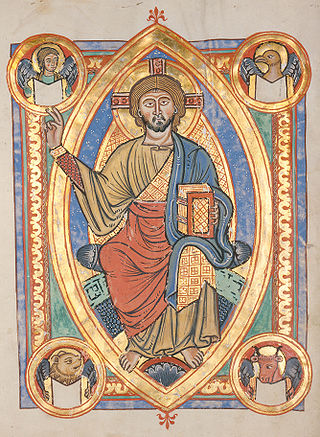
Crux is a constellation of the southern sky that is centred on four bright stars in a cross-shaped asterism commonly known as the Southern Cross. It lies on the southern end of the Milky Way's visible band. The name Crux is Latin for cross. Even though it is the smallest of all 88 modern constellations, Crux is among the most easily distinguished as its four main stars each have an apparent visual magnitude brighter than +2.8. It has attained a high level of cultural significance in many Southern Hemisphere states and nations.

A cross is a geometrical figure consisting of two intersecting lines or bars, usually perpendicular to each other. The lines usually run vertically and horizontally. A cross of oblique lines, in the shape of the Latin letter X, is termed a saltire in heraldic terminology.

Franz Liszt was a Hungarian composer, virtuoso pianist, conductor, and teacher of the Romantic period. With a diverse body of work spanning more than six decades, he is considered to be one of the most prolific and influential composers of his era, and his piano works continue to be widely performed and recorded.

Mimosa is the second-brightest object in the southern constellation of Crux, and the 20th-brightest star in the night sky. It has the Bayer designation β Crucis, which is Latinised to Beta Crucis and abbreviated Beta Cru or β Cru. Mimosa forms part of the prominent asterism called the Southern Cross. It is a binary star or a possible triple star system.

The Stations of the Cross or the Way of the Cross, also known as the Way of Sorrows or the Via Crucis, refers to a series of images depicting Jesus Christ on the day of his crucifixion and accompanying prayers. The stations grew out of imitations of the Via Dolorosa in Jerusalem, which is a traditional processional route symbolising the path Jesus walked to Mount Calvary. The objective of the stations is to help the Christian faithful to make a spiritual pilgrimage through contemplation of the Passion of Christ. It has become one of the most popular devotions and the stations can be found in many Western Christian churches, including those in the Roman Catholic, Lutheran, Anglican, and Methodist traditions.
Valle Crucis is a Latin phrase meaning "valley of the cross", and may refer to:
Holy Cross Procession may refer to one of the following:
Titulus, the Latin word for "title", "label" or "inscription", may or may not be italicized as a foreign word, and may refer to:
Christ is a title given to Jesus, in his role as the Jewish Messiah in Christianity.
The radical change Franz Liszt's compositional style underwent in the last 20 years of his life was unprecedented in Western classical music. The tradition of music had been one of unified progression, even to the extent of Johannes Brahms' First Symphony being known as "Beethoven's Tenth". Beethoven's own three periods of composition are monolithic and united. Liszt's, by comparison, seem deconstructivist. Replacing pages which in Liszt's earlier compositions had been thick with notes and virtuoso passages was a starkness where every note and rest was carefully weighed and calculated, while the works themselves become more experimental harmonically and formally.

The Via Crucis to the Cruz del Campo in Seville, Andalusia, Spain is believed to be Spain's only Via Crucis that runs through the streets of a city. It is the basis of the famous traditions of Holy Week in Seville. Since the Via Crucis was first laid out in 1521, both the starting and ending points have changed, as has the number of stations.

The Christian cross, seen as a representation of the crucifixion of Jesus on a large wooden cross, is a symbol of Christianity. It is related to the crucifix and to the more general family of cross symbols, the term cross itself being detached from the original specifically Christian meaning in modern English.
Lisztomania was the intense fan frenzy directed toward Franz Liszt during his performances.
Feuille d'album may refer to:

Lambertus Reiner "Reinbert" de Leeuw was a Dutch conductor, pianist and composer.
Dreams of Love or Dream of Love may refer to:

Via Crucis, S.53, is a work for mixed choir, soloists and organ by Franz Liszt. The work is devoted to the Stations of the Cross. It is one of the last works of Liszt.
This page is based on this
Wikipedia article Text is available under the
CC BY-SA 4.0 license; additional terms may apply.
Images, videos and audio are available under their respective licenses.








